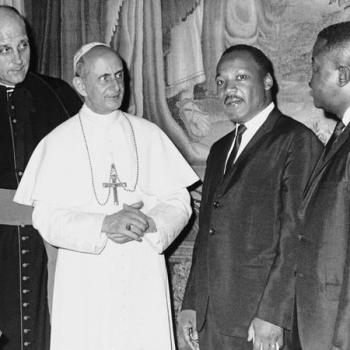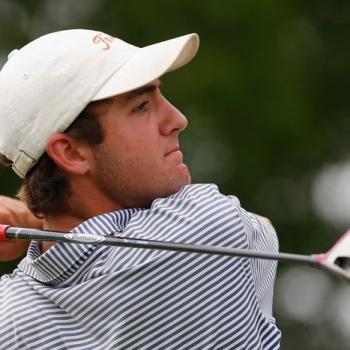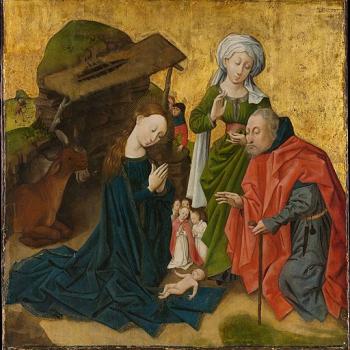Now Featured in the Patheos Book Club
52 Ways to Live the Course in Miracles: Cultivate a Simpler, Slower, More Love-Filled Life
by Karen Casey
Love is letting go of fear.
More than thirty-five years ago, I was introduced to the spiritual principle “love is letting go of fear” through a book by that name written by Dr. Gerald Jampolsky. I knew nothing about A Course in Miracles at that time, but the idea that the connection between love and fear, a very core idea in A Course in Miracles, needed to be reckoned with got my attention. Dr. Jampolsky was best known then as the founder of the Center for Attitudinal Healing, a program he started in Marin County, California, in the mid-1970s that brought comfort and spiritual healing to children suffering from cancer.
I was particularly drawn to Jampolsky’s writing style. His message was gentle. Very healing. Easily accessible. And extremely practical. The crux of his small book was about changing one’s mind, thus making it possible to live from a place of love rather than being controlled by fear. His twelve simple principles seemed revolutionary to me. I didn’t have any idea when I read his book that Jampolsky was a devotee of A Course in Miracles or that his words would guide me to becoming a student of the course a short time later, but indeed that was the journey I embarked on. And what a journey it has been.
I’d have to say that nearly every spiritual perspective I now cherish is one that has been influenced by something I read either in the 669-page text, the 488-page workbook, or the 92-page manual for teachers that comprise A Course in Miracles. I’m so grateful for the vision I am now guided by. It’s a simple vision. It’s a practical vision. And it’s a gentle vision, not unlike the one I was so comforted by when I read Love Is Letting Go of Fear more than thirty-five years ago.
Living life in the simple lane appeals to me. And there is nothing quite as simple as recognizing that every expression, every word, and every action any one of us makes is motivated by one of two feelings: love or fear. When I was first introduced to this idea, I scoffed. Surely people’s behavior was more complicated than that. Indeed, I was certain mine was. And then I was helped by the readings in the course, coupled with long discussions with other course students, A Course in Miracles workshops, and books by Marianne Williamson, Kenneth Wapnick, and Jon Mundy, to see how much less complicated most of us really are. Fear absolutely motivates people to be angry, sullen, dismissive, and, far too often, cruel. It can also initiate violence in myriad forms. Cable news, minute by minute, alerts us to the most recent evidence of fear in action. In families and between countries. In our neighborhoods and among folks we will never meet.
Fear is powerful. And all-pervasive at times. With some individuals it seems unending too. My own dad fell into this category. I’m pretty certain he would have insisted that he loved my siblings, my mother, and me; however, his love felt compromised, very conditional. And most of the time he was tense and quick to anger. Perhaps something had happened at work that upset him. Or maybe one of my siblings left a bike in the driveway. Something big or minor could have triggered the rage. But the repercussions were always registered at home. Always. Quite often at the supper table.
It wasn’t until years later, after I was encouraged to interview him for a class assignment about family origins, that I came face to face with who my dad really was. My simple question, “Will you tell me about your life?” resulted in the reply, “I have been afraid every single day since I was six years old.” He told me he had accidentally cut off two of his younger brother’s fingers with the old push lawn mower and was severely punished for it. Trying to be perfect, in every way, from that moment forward instilled a fear that simply couldn’t be quelled. He was tormented by it until the day he died. I was stunned. My dad, afraid? He always seemed so confident. What I didn’t understand then, but eventually learned from my Course in Miracles teachers, was that anger is only one of the many masks hiding fear. Let me be clear. My dad was angry. Often. But finally realizing that fear had precipitated his anger was eye-opening.
The only sane response to someone else’s fear, regardless of how it is being manifested, is to be loving.
I was relieved to finally learn my dad’s truth, but so sad for him that life had been so difficult. His near-constant struggle, of course, made life a struggle for all of us. That’s what fear does. It gets projected onto others, thus controlling the dynamic between all the people present. The dance our family did was anything but a smooth waltz.




